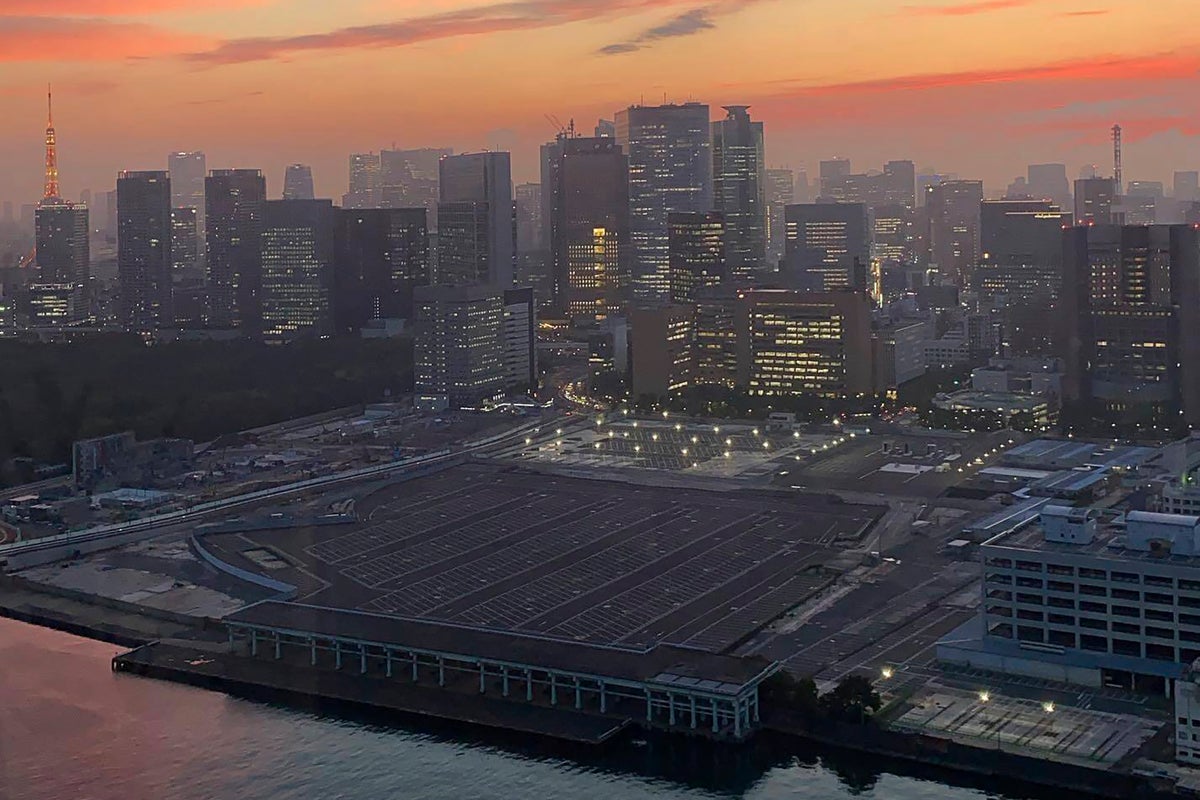
The site of Tokyo’s famed Tsukiji fish market, left empty after it was razed six years ago, will be replaced by a scenic waterfront stadium and glistening skyscrapers according to plans for its redevelopment that are facing some staunch opposition.
A computer graphic video of plans for the 900 billion yen ($5.7 billion) project made by property developer Mitsui Fudosan shows air taxis zipping above the Sumida river, famed for its scenic bridges.
It’s the latest vision for what is to replace the old market famous for its tuna auctions and pre-dawn fresher-than-fresh sushi meals in shops nearby.
Mitsui Fudosan says the new development will rival top waterfront spots in places like Sydney and Singapore. The idea is to draw in plenty of people from both Japan and abroad. But some in Tokyo are opposed and would prefer to see the prime site turned into a garden.
The plans include office buildings, event spaces, greenery and residential areas, hotels and a biotechnology research center. Also, plenty of places to shop and eat out.
“We are entering a new chapter. Over the years of Japan's modernization, waterfronts were used for warehouses and factories,” said Jiro Ueda, an executive overseeing development planning at major real estate company Mitsui Fudosan, which heads the consortium that won the bid to redevelop the area.
“We want to build facilities for sports and entertainment to move people emotionally. We want to make Japan more economically competitive.”
The consortium includes a powerful lineup including Toyota Motor, Toyota Fudosan, the Kajima, Taisei, Shimizu and Takenaka construction groups, engineering companies Nikken Sekkei and Pacific Consultants and media groups Asahi Shimbun and the Yomiuri Shimbun Group, whose baseball team, the Yomiuri Giants, may use the new arena as its home stadium.
For now, the area that used to be the sprawling main fish market is just a vacant 190,000 square-meter (47-acre) area of cement about the size of 35 football fields, with a few construction machines and a small area that has been dug up.
The city-owned land beside the Sumida River is within walking distance of the glitzy downtown Ginza and across a small bridge from Hamarikyu, a traditional Japanese garden with sculpted pine trees, a small forest and a tea house.
What’s left of the old Tsukiji market, a quaint “retro” area packed with sushi and ice cream stalls called the “jogai” or “outer area” of the market, will be kept like it is, right next to the modern development.
The fish market functions of Tsukiji were moved in 2018 to a more modern, bigger warehouse-like facility in another area of Tokyo Bay called Toyosu.
After the market’s buildings were demolished, the empty lot was used for parking during the Tokyo Olympics, which were delayed by a year to 2021 because of the pandemic. The city called for bids in 2022 and in April chose the consortium headed by Mitsui, a participant in the Hudson Yards megadevelopment in Manhattan, New York. Initial construction is due to begin next year.
“Tsukiji is a special place for Tokyo. It’s so close to downtown, yet it’s surrounded by waterways and greenery,” said city hall official Takuo Takano. “It will become the face of Tokyo,” Takano told The Associated Press.
The project building will connect ferries on the city’s rivers and Tokyo Bay with city subway lines and provide a showcase venue for international conventions, trade shows and summits as well as tourism.
The Tsukiji project “will be like a giant city in itself,” said Sachiko Okada, an analyst at Goldman Sachs.
“That location pick is right on the dot,” she said.
Some groups in the city earlier opposed moving the century-old fish market, a city landmark, to Toyosu, and some still oppose the project, saying building skyscrapers will add to pollution in the area.
A garden would be a better alternative, says Shizuko Nagaya, who consults on ecological issues. She also worries about the safety of the densely populated complexes on the land, reclaimed from Tokyo Bay in the 17th century, if a major earthquake hits as expected.
“This is a piece of land that belongs to the people,” said Nagaya, who researches history and waterways. “We need a place with a blue sky, the sea breeze and lots of green, where our future children can play.”
Christian Dimmer, a professor of urban studies at Waseda University in Tokyo, believes the fish market should have stayed where it was, and developers should leverage the historical and cultural legacy of cities.
“Removing the fish market, relocating it far away to Toyosu, and replacing it with yet another luxury housing, hotel, shopping and entertainment complex makes central Tokyo less exciting and more mono-functional,” he said.
“The question must be asked whether the current redevelopment model is sustainable. Yet, despite this and other insights, the scrap-and-build development model of Tokyo is still largely unchallenged.”
City officials say final details of the development are still undecided. Plenty of time will be allowed for public feedback, they say.
Mitsui Fudosan is facing criticism over other projects, including redevelopment of the leafy Jingu Gaien area between Tokyo’s Meiji Shrine and the Imperial Palace. Opponents of the project, which involves renovating two sports arenas, especially object to the loss of famous rows of gingko trees in the area’s streets. The company says the trees and overall natural landscape will be preserved.







